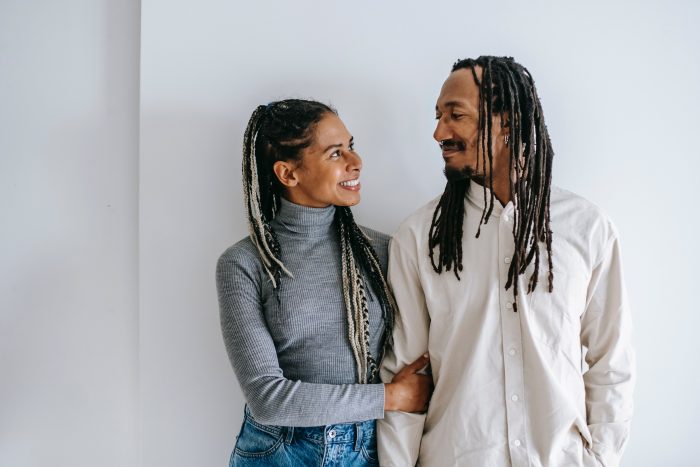When I was a child, I loved ladybugs.
I would let them crawl on my hands and I would cry each time they flew away. Because I didn’t want them to leave, I decided to catch them and close them in a jar. I was happy until I realized that they would soon die from suffocation.
The act of closing them in a jar wasn’t an act of love. It was my own selfish need accompanied by a lack of understanding. It was a painful but valuable lesson. A lesson that I carried with me into my adulthood.
The problem is that we often mistake the idea of love for attachment, lust, or approval. We imagine that by clinging to something, we demonstrate our love and care for it.
And the more we grasp, the more we’re afraid to lose it.
The difference between attachment and genuine love is that love is confident in its expression. The quality of love has a nurturing touch that allows for things to unfold.
In an ideal world, two people who feel whole and secure within themselves find each other and decide to share their life journeys together. However, more often than not, we see people bonding based on their subconscious attempts to fill the void within or heal the wounds from childhood. Relationships become a means to compensate for the lack that they feel inside, and they expect another person to supply or substitute that which they don’t feel on their own.
When we’re infants, our survival depends on our caregivers. Therefore, emotional bonding is an innate biological need.
Attachment theory illustrates that the way in which we formed bonding with our primary caregivers during our childhood creates an imprint that continues to affect our adult relationships.
Our attachment style explains why we’re attracted to certain types of people or why we keep recreating certain dysfunctional patterns in our relationships.
If we expand our awareness, we may be surprised to uncover that many choices and decisions in our lives are not necessarily conscious, but rather, default programs operating from our subconscious.
Psychologists differentiate three main types of insecure attachment:
Anxious-preoccupied attachment style
These people tend to crave intimacy and are likely to be clingy. They’re stuck in their fantasies about what a relationship could be rather than seeing it for what it is now.
It looks a bit like this:
I’ve been dating this guy for two weeks. I’m worried that he doesn’t find me attractive enough. I’m obsessing about whether or not he’s going to call me back! I know that, once again, I’ll manage to turn all my fears about not being good enough into a self-fulfilling prophecy. By being too clingy, I will scare him away and ruin yet another chance at a relationship!
Dismissive-avoidant attachment style
These people equate intimacy with a loss of independence. They’re uncomfortable with commitment. As a result, they end up pushing people away before they get a chance to develop true closeness.
Example:
What’s wrong with me? I’m a smart, good-looking, ambitious guy. I’ve dated some stunning women, but inevitably, after a few weeks I lose interest and start to feel trapped. It shouldn’t be this hard to find someone I’m compatible with.
Fearful-avoidant attachment style
These people tend to be somewhat “hot and cold.” They have a strong need for connection, and at the same time, they’re afraid of commitment and intimacy, and therefore—push people away.
Personally, I used to be this type.
My previous relationships could be characterized by being one foot in and one foot out. I wanted connection, but at the same time, I pushed people away. The closer I got to someone, the more I felt like losing myself. I felt torn inside. I believed that I couldn’t be loved for who I was. That I wasn’t worthy of love, nor good enough. And so, I abandoned myself to fit into other people’s idea of an ideal partner. I kept going back and forth until I became aware of this pattern and consciously chose to work through it. I had to relearn my boundaries and rediscover my true self.
My fear of commitment contained a message, a solution. I didn’t have to change myself in order to be accepted. Rather, by being authentic, I attracted people who accepted me exactly for who I was. I learned I could have myself and be in the relationship at the same time. I didn’t have to trade one for the other.
If you’re not sure which category of attachment style you fall into, I’ve put together this quiz to make it easier for you.
Seeing the examples of insecure attachments, let’s look at what a healthy relationship looks like.
Emotionally secure people are comfortable with intimacy, with communicating their needs, and expressing warmth and affection. They don’t play games. They keep promises. They’re transparent and don’t send mixed messages. They derive a sense of worth within themselves rather than deriving it from others, but at the same time, they recognize the need for love, and for giving and receiving love from others. They’re supportive and can hold space for their partner when they’re going through challenging times.
They celebrate their partner’s achievements. They have healthy boundaries and know how to honor and communicate them. They speak the truth even if it’s uncomfortable. They’re consistent. They seek to resolve conflicts and communicate about issues, rather than withdraw, suppress, or deny the problems. They embrace their own other people’s vulnerabilities without mocking or shaming them. They own their mistakes and apologize or make amends if required. They understand their partner’s love language and invest time and effort to nurture the relationship. They have their partner’s best interest at heart.
Good relationships don’t just happen. They require us to put in the necessary work, love, dedication, and mutual commitment. Romantic movies only portray one chapter of the relationship. The truth is, there is no such thing as a happy ending, as every day is a new beginning in a relationship.
As we change and evolve, so do our relationships. These changes may present new challenges. By overcoming these challenges, we can uncover deeper levels of intimacy. Many of us don’t really have examples or templates of what a healthy relationship looks like. Even if we do, everyone and every relationship is unique. Let’s just continue to learn as we go.
You can find the quiz, here.
I will end this article with a quote:
“Give the ones you love wings to fly, roots to come back, and reasons to stay.” ~ Dalai Lama.








Read 18 comments and reply